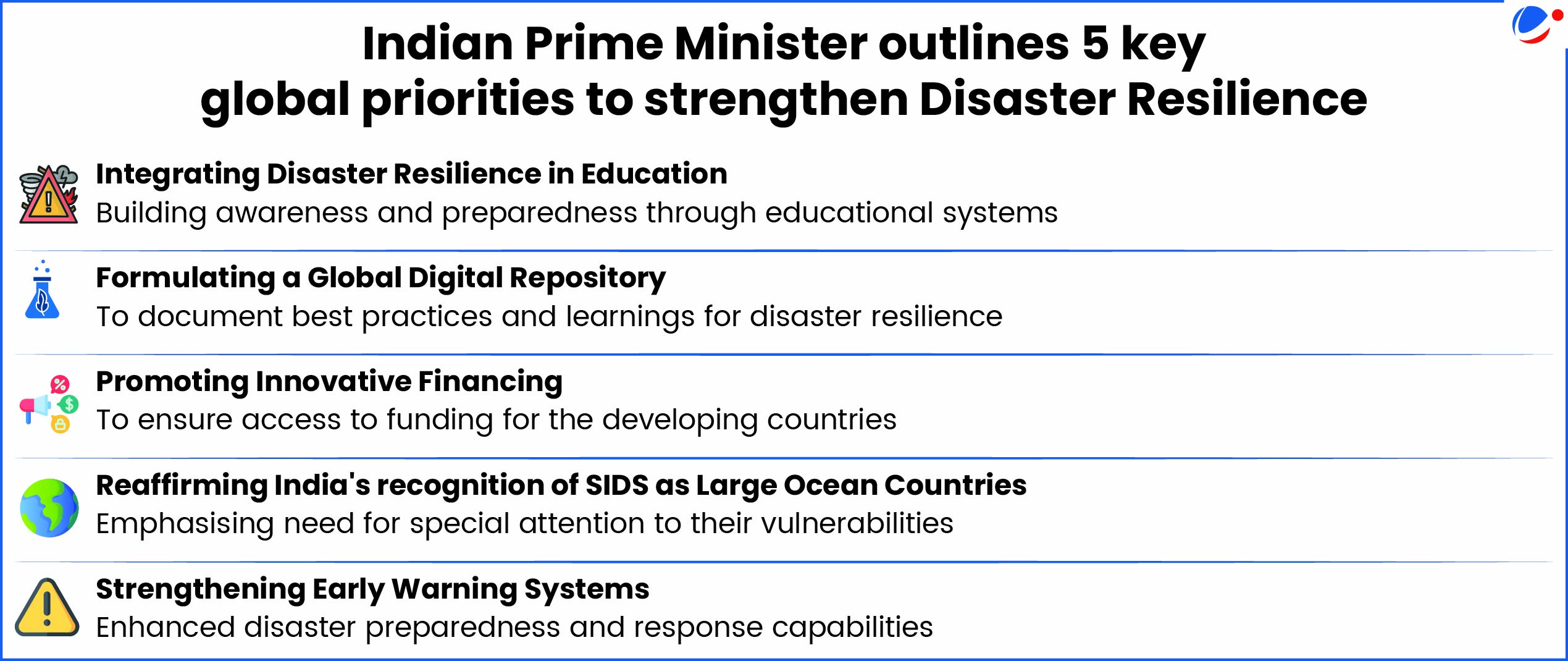Why in the News?
Recently, the African Union joined India's Coalition for Disaster Resilient Infrastructure at the 7th International Conference on Disaster Resilient Infrastructure (ICDRI) in France.
More on News
- ICDRI 2025 has launched a call to action for coastal resilience in SIDS (Small Island Developing States).
- ICDRI is a platform under the Coalition of Disaster Resilient Infrastructure (CDRI) to drive discussions and actions on climate adaptation, coastal resilience, and sustainable development.
- This year's conference is the first to be held in Europe and is being co-hosted by the CDRI and the Government of France.
- The theme of the conference is shaping a Resilient Future for Coastal Regions.

Vulnerability of Coastal Regions
- Risk to Human life and Property: Coastal regions globally are highly vulnerable to hazards, with over 60% of the world's population and two-thirds of its large cities located in coastal zones.
- Nearly 250 million people live within the area of 50 km from the coastline of India.
- Climate change: It is projected to increase threats in coastal regions by increasing the intensity and frequency of hazards like sea level rise, floods, and storms.
- Economic losses: E.g., Cyclone Fani caused ~US$1.2 billion power infrastructure damages in Odisha (2019). (Global Assessment Report (GAR), 2025)
- Threat to Ecosystems and biodiversity: For example, half of the world's mangroves could face severe risks by 2100 due to increased cyclone frequency and sea level rise, according to risk index for mangroves.
- Social Vulnerability: Coastal hazards are expected to worsen existing inequities for socially vulnerable populations in coastal areas, including the elderly, Indigenous fishing communities, etc.
- Severe coastal hazards are:
- Tsunamis: For example, the 2004 Indian Ocean Tsunami claimed over 230,000 lives, displaced millions, and devastated coastal regions across 14 countries, including India.
- Cyclones: For example, Cyclone Remal struck India and Bangladesh in 2024.
- Storm Surges: For example, an estimated storm surge of height 2-2.5 m above astronomical tide inundated the low-lying areas of Kutch and Morbi districts in 2023. (IMD)
- Coastal Erosion: For example, 33.6% of India's coastline is threatened by erosion (MoEFCC).
About Coalition for Disaster Resilient Infrastructure (CDRI)
|
Indian Initiatives for Mitigating Coastal Vulnerabilities
- Coastal Regulation Zone (CRZ) Notification (2019): It aims to conserve and protect coastal stretches, marine areas and to ensure livelihood security to the fisher and other local communities.
- Integrated Coastal Zone Management Project (ICZMP): Implemented in states like Odisha and West Bengal, and aims to protect and conserve coastal and marine environments through sustainable practices.
- Coastal Vulnerability Index (CVI): The Indian National Centre for Ocean Information Services (INCOIS) has developed the CVI to assess and map the vulnerability of different coastal regions based on various parameters.
- Multi-Hazard Vulnerability Maps: INCOIS has developed detailed maps to identify areas vulnerable to coastal hazards.
- Coastal Management Information System (CMIS): It is a data collection activity carried out to collect near-shore coastal data, which can be used in planning, design, and construction of site-specific coastal protection structures.
- National Action Plan on Climate Change (NAPCC): The plan includes missions like the National Water Mission, which indirectly supports coastal resilience by promoting sustainable water and forestry management practices.
Conclusion
Coastal regions and island nations face rising threats from sea level rise, cyclones, erosion, and extreme weather. India, through the CDRI and its initiatives, is driving efforts to build resilient and inclusive infrastructure. As climate risks grow, global action grounded in local needs and innovation is vital to safeguard coastal communities and ecosystems.



